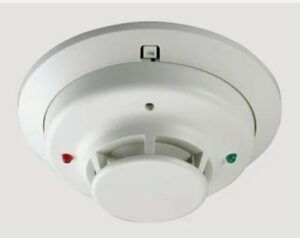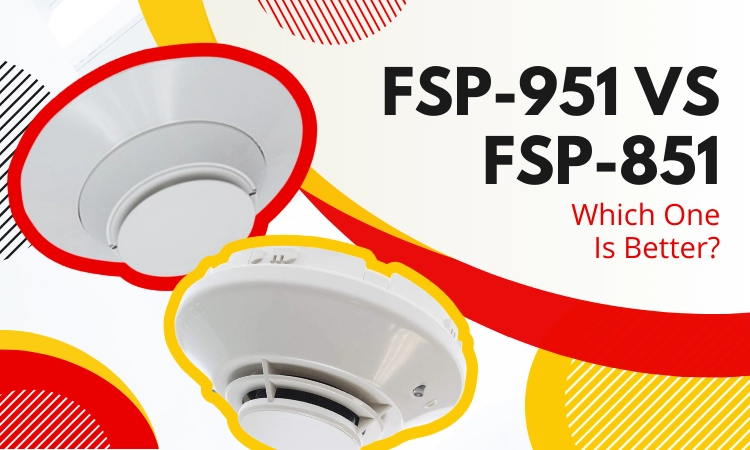The FSP-851 smoke detector by notifier has been a popular choice among users. But the new FSP-951 has been introduced as the direct replacement for FSP-851. As a result, both smoke detectors are almost identical.
But which one is better between FSP-951 vs FSP-851?
FSP-951 is the better smoke detector when compared with the FSP-851 series. The FSP-951 has separate bases for photoelectric, thermal, and ionization sensor. Whereas FSP-851 only has a photoelectric sensor. FSP-951 is cheaper and digitally addressable. It also draws less power than FSP-851.
Join us in the thorough discussion to discover more details. Let’s start!
FSP-951 vs FSP-851: Quick Comparison
Smoke detectors are an important component in a fire suppression system. So, it’s important that you take time to know the details about them.
Before we go on to the long discussion, let’s see the major differences at a glance.
| Aspect | FSP-951 | FSP-851 |
| Sensor Type | Photoelectric, Ionization, Thermal | Photoelectric |
| Device Communication System | Digitally Addressable | Analog addressable |
| Standby Current | 200 μA | 300 μA |
| Cost | Cheaper | Expensive |
The details will be elaborated in the next section.
FSP-951 vs FSP-851: Detailed Comparison
Although both detectors have many similarities, there are a few significant changes in both models. Let’s see in-depth to them.
Sensor Type:

The FSP-851 smoke detectors have a base for photoelectric sensors. Whereas the FSP-951 series smoke detectors have separate bases for photoelectric, ionization, and thermal sensors.
Photoelectric sensors use a light detector to detect smoke. Under normal conditions, the detector doesn’t get affected by lights. But when there’s smoke in the air, it deforms the light rays.
The deformed rays strike the light sensor, and thus, triggering the alarm. Photoelectric detectors are best at detecting slow-burning or smoldering fires.
Ionization sensors on the other hand contain radioactive material. It helps ionize the air and causes an electric current to flow between two opposingly charged particles.
When the smoke enters the sensor chamber, it interrupts the flow of electricity and causes the alarm to sound. Ionization smoke detectors are best for detecting large fires such as wildfires, grease, or paper burns.
Now, the FSP-951 is both a photoelectric and an ionization smoke detector. Additionally, it is a thermal smoke detector as well.
Which means it can also detect heat from the energy emission. Due to having three bases for each sensor, FSP-951 is a more reliable option.
It can detect smoke faster than FSP-851. So, if your fire alarm makes a whoop whoop noise, at least you’ll get more time to evacuate.
As the FSP-851 only has a photoelectric sensor, it is not as reliable as the latest FSP-951 series. Combined smoke detectors are always better than detectors with a single sensor.
Smart Features:
When it comes to features both FSP-851 and 951 are quite identical. However, FSP-951 has gained a few improved features. Let’s start with the SLC loop.
Both these series have a two-wire SLC loop connection and are compatible with CLIP protocol and FlashScan. However, FSP-951 has the unit’s wiring done through the base.
Which means a more secure connection in the circuit. The FSP-951 uses the built-in device type recognition process. It is a digital addressable device whereas FSP-851 is analog addressable.
Addressable devices have a distinctive identification number. The number can be associated via Bluetooth or wifi and connects to smartphones.
Which makes your smoke detector even smarter as it can notify you through other devices. So, even if you’re not at home, your smoke detector can notify you of any impending danger.
You’ll also be able to track your smoke detector with this unique ID number. Whether it’s an analog or digital addressable device the functionality is the same.
But what makes them different is the accuracy rate. Digital addressable devices deliver more reliable information than analog ones.
Analog signals have the tendency to distort. So the quality of the signal is often questionable. Digital signal on the other hand doesn’t have noise or distortion issues.
So, there’s less chance of false alerts as well. Situations like the CO detector going off twice and then stopping are less likely to happen. This makes the FSP-951 a better option.
Electrical Specification:
FSP-951 and FSP-851 both have a voltage rate of 15-32 volts at the DC peak. But the standby current varies for both devices. FSP-951 has the maximum standby current rate of 200 microamperes.
FSP-851 has a maximum standby current rate of 300 microamperes. This means FSP-851 draws more current from the power supply. FSP-951 draws less energy.
So, it’s better to switch to FSP-951 if you want to save money on your electricity bill.
Cost:
Although notifier FSP-851 is the older model comparatively, it costs more than the FSP-951. It is more expensive than the FSP-951 series.
Whereas FSP-951 is cheaper and has more advantageous features than FSP-851.
FSP-951 vs FSP-851: Which One Should You Get?
Considering all the categories, notifier FSP-951 wins the battle. It has upgraded features, more sensors, and better electric specifications. So, it’s definitely the betterchoice between the two.
It is cheaper and can ensure you better security service thanks to the multiple sensor systems. However, this doesn’t mean notifier FSP-851 is a bad smoke detector.
It performs perfectly well. Both are good smoke detectors. FSP-951 is just slightly updated.
Frequently Asked Questions (FAQs):
Where to place smoke detectors and carbon monoxide detectors?
NFPA suggests installing smoke detectors on each floor, in bedrooms, hallways, stairways, and in the basement. Basically, any living and sleeping area in the building should have a smoke detector. But avoid installing them near heating appliances like heaters, furnaces, stoves, etc.
How to turn off a smoke alarm without battery?
To turn off a smoke alarm that doesn’t have a battery, you’ve to drain the residual charge. Smoke detectors can stay functional even after removing the battery due to the residual charge. It can keep the alarm going for about 7 days. If you press the test button for 15 seconds the charge will drain.
What is a dual-sensor smoke alarm?
A dual-sensor smoke alarm is a combination of ionization and photoelectric technology. It uses both light beams and electric flow to determine smoke presence. Dual sensors are the best type of smoke detectors. Because it can detect both slow and fast-burning fires.
Conclusion
That’s all from us regarding fsp-951 vs fsp-851 smoke detectors. Hopefully, we were able to help you figure out the best option between these two.
Don’t forget to check the warranty of the device while buying. Make sure you install the device by an expert.
Good luck!

